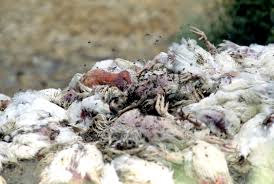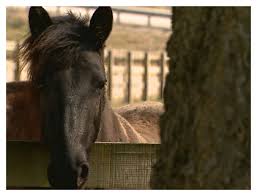Food-chain unraveling: Livestock plagues hit U.S., Nepal, and UK, mystery virus killing numerous animals

February 27, 2012 – BRITAIN - Thousands of lambs are dying in Britain. The Schmallenberg virus causes lambs to be born dead or with serious deformities such as fused limbs and twisted necks, which mean they cannot survive. Scientists are urgently trying to find out how the disease, which also affects cattle, spreads and how to fight it, as the number of farms affected increases by the day. So far, 74 farms across southern and eastern England have been hit by the virus, which arrived in this country in January. A thousand farms in Europe have reported cases since the first signs of the virus were seen in the German town of Schmallenberg last summer. The National Farmers Union has called it a potential “catastrophe” and warned farmers to be vigilant. “This is a ticking time bomb,” said Alastair Mackintosh, of the NFU. “We don’t yet know the extent of the disease. We only find out the damage when sheep and cows give birth, and by then it’s too late.” It is unclear exactly how the disease arrived in Britain, but the leading theory is that midges carried the virus across the Channel or North Sea in the autumn. However, scientists cannot yet rule out transmission of the disease from animal to animal. Infected ewes do not show any symptoms of the virus until they give birth, with horrific results. Farmers have described delivering the deformed and stillborn animals as heartbreaking. The lambing season has only just begun, which means that the full impact of the disease will not be felt until the weather warms up and millions more animals are born. On the Continent, some farms have lost half of their lambs. So far the worst hit in Britain have lost 20 per cent, according to the Department for Environment, Food and Rural Affairs (Defra). Approximately 16 million lambs are born in Britain every year and sell at market for about £100 each. The effect of the disease on farms that are already struggling in the downturn could be severe. –Telegraph
only find out the damage when sheep and cows give birth, and by then it’s too late.” It is unclear exactly how the disease arrived in Britain, but the leading theory is that midges carried the virus across the Channel or North Sea in the autumn. However, scientists cannot yet rule out transmission of the disease from animal to animal. Infected ewes do not show any symptoms of the virus until they give birth, with horrific results. Farmers have described delivering the deformed and stillborn animals as heartbreaking. The lambing season has only just begun, which means that the full impact of the disease will not be felt until the weather warms up and millions more animals are born. On the Continent, some farms have lost half of their lambs. So far the worst hit in Britain have lost 20 per cent, according to the Department for Environment, Food and Rural Affairs (Defra). Approximately 16 million lambs are born in Britain every year and sell at market for about £100 each. The effect of the disease on farms that are already struggling in the downturn could be severe. –Telegraph
 DHADING, Nepal – More than 20,000 chickens have died of unidentified disease in Naubise VDC’s Dharke and surrounding areas in the past one week. Livestock Development Officer Dr Shivaji Prasad Das of District Livestock Service Office said chickens had been dying but since the farmers kept mum more chickens could not be prevented from dying. It was only yesterday that a team including Dr Das went to the incident site. It sent dead chickens for tests to Kathmandu’s Central Livestock Disease Control Laboratory today. According to Dr Das, test report will be out in three days. In the poultry farm owned by Ram Koirala of Dharke 3,500 died within two weeks. In Salikgram’s farm 3,000 fowls have died. Thousands of chickens have died in other farms as well. Farmers estimate that they have lost more than Rs 50 lakhs. Ram Koirala, Proprietor of Dharke-based Ram Laxman Poultry Farm, said, “We had taken the chickens to Kathmandu’s Gauri Shankar Vet Farm as soon as we found out they were suffering from some disease. The vets there said chickens suffered from Ranikhet disease.” Farmers are worried that chickens are dying even after treatment of Ranikhet disease. Meanwhile, the Cabinet decided today to declare three districts of eastern region — Ilam, Sunsari and Jhapa — as bird flu affected areas and directed the government agencies to adopt effective measures to control the disease. – The Himalayan Times
DHADING, Nepal – More than 20,000 chickens have died of unidentified disease in Naubise VDC’s Dharke and surrounding areas in the past one week. Livestock Development Officer Dr Shivaji Prasad Das of District Livestock Service Office said chickens had been dying but since the farmers kept mum more chickens could not be prevented from dying. It was only yesterday that a team including Dr Das went to the incident site. It sent dead chickens for tests to Kathmandu’s Central Livestock Disease Control Laboratory today. According to Dr Das, test report will be out in three days. In the poultry farm owned by Ram Koirala of Dharke 3,500 died within two weeks. In Salikgram’s farm 3,000 fowls have died. Thousands of chickens have died in other farms as well. Farmers estimate that they have lost more than Rs 50 lakhs. Ram Koirala, Proprietor of Dharke-based Ram Laxman Poultry Farm, said, “We had taken the chickens to Kathmandu’s Gauri Shankar Vet Farm as soon as we found out they were suffering from some disease. The vets there said chickens suffered from Ranikhet disease.” Farmers are worried that chickens are dying even after treatment of Ranikhet disease. Meanwhile, the Cabinet decided today to declare three districts of eastern region — Ilam, Sunsari and Jhapa — as bird flu affected areas and directed the government agencies to adopt effective measures to control the disease. – The Himalayan Times
 MAURY COUNTY, Tenn. — Horses are dying and now cattle as well and detectives in Maury County have been at a loss to explain how or why it is happening. First, seven seemingly healthy horses turned up dead last week at a Hampshire farm in Maury County. The state performed a necropsy and released the results. “They ruled that it’s undetermined. The cause of death cannot be determined at this time. It is a mystery. We don’t know what happened,” said Detective Terry Chandler with the Maury County Sheriff’s Department. Now Detective Chandler is investigating more deaths: Two dead cows at a farm across from the one where the seven horses were found. And he’s consulting with police looking into more mysterious horse deaths in Dickson and Giles County. Chandler said there is no evidence anyone is intentionally harming the animals. He said they have not ruled out the possibility the livestock died from eating contaminated hay or a poison plant. It’s possible the toxins were not detected by the state testing. –News Channel 5
MAURY COUNTY, Tenn. — Horses are dying and now cattle as well and detectives in Maury County have been at a loss to explain how or why it is happening. First, seven seemingly healthy horses turned up dead last week at a Hampshire farm in Maury County. The state performed a necropsy and released the results. “They ruled that it’s undetermined. The cause of death cannot be determined at this time. It is a mystery. We don’t know what happened,” said Detective Terry Chandler with the Maury County Sheriff’s Department. Now Detective Chandler is investigating more deaths: Two dead cows at a farm across from the one where the seven horses were found. And he’s consulting with police looking into more mysterious horse deaths in Dickson and Giles County. Chandler said there is no evidence anyone is intentionally harming the animals. He said they have not ruled out the possibility the livestock died from eating contaminated hay or a poison plant. It’s possible the toxins were not detected by the state testing. –News Channel 5
